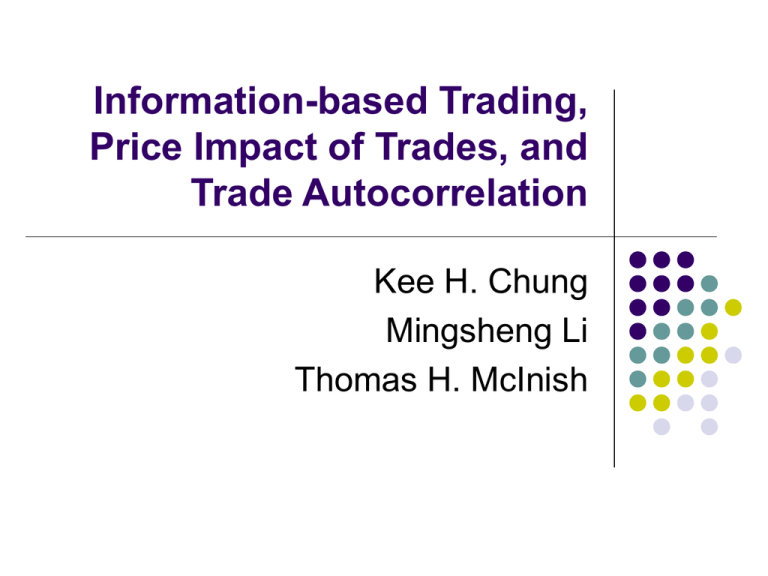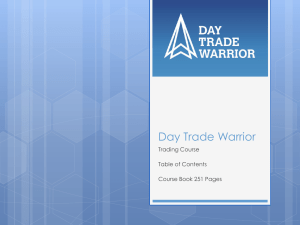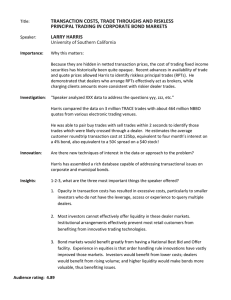Chung McInish Li.ppt
advertisement

Information-based Trading, Price Impact of Trades, and Trade Autocorrelation Kee H. Chung Mingsheng Li Thomas H. McInish Motivation To address the following three questions: What is the extent to which quote revisions are driven by informational reasons? Does informed traders’ strategic trading result in serial correlation in trade direction? How does informed trading influence the effect of trading intensity on quote revision? Informed Trading & Price Impact Hasbrouck (1988, 1991a ,1991b) Trades trigger quote revision, but driven by various reasons. Easley, Kiefer, and O’Hara (1997b) The market makers revise quotes according to the probability of information-based trading. The size of the market makers’ quote revision is positively related to the probability of informed trading. Stoll (1978, 1989) The price impact may result mainly from the specialist’s inventory control. Informed Trading & Serial Correlation in Trade Direction Hasbrouck (1991a): Institutional/market microstructure factors, such as price continuity rules, specialist inventory control, trade reporting practices, may cause serial correlation in trade direction. Chan and Lakonishok (1993, 1995) Institutional investors minimize execution costs by spreading trades in a single security across time, even in the absence of private information. Kyle (1985) The informed trader chooses trade size strategically to maximize his expected profit, which will cause serial correlation. Informed Trading & Serial Correlation in Trade Direction---Con’d Convig and Ng (2004) Institutional trading produces greater clustering of trades than individual investor trading during periods of information flow. Kelly and Steigerwald (2001) the entry and exit of informed traders in response to the random arrival of private information implies that trades are serially correlated. The size of serial correlation in trade direction increases with the probability of informed-based trading. Trade Time Interval & Price Impact Dufour and Engle (2000) Times of active trading reflect an increased presence of informed trading. Price impact of trades, the speed of price adjustment to traderelated information and the positive autocorrelation in signed trades all increases as the time duration between transactions decreases. Stoll (1978) Dealer inventory problem decreases with trading activity because it is easier for them to reverse their inventory positions when volume is higher. Price impact of trades decreases as the time duration between transaction decreases. Relations Informed Trading Quote Revision Price Impact Inventory Control Quote Revision Price Impact Correlated with PIN Uncorrelated with PIN Informed Trading Positive serial correlation in trade direction The size increases with PIN Liquidity Trading Positive serial correlation in trade direction The size uncorrelated with PIN Informed Trading Trade Interval Price Impact Liquidity Trading Trade Interval Price Impact Methodology: VAR Model The total price impact can be decomposed into informational (permanent) and non-informational (transitory) components. the expected cumulative quote revision5 conditional on v2,0 captures the permanent price impact bi . i 0 The quote revisions and trades can be expressed as a linear function of current and past innovations and the above VAR model can be transformed into a vector moving average (VMA) model. Methodology: VAR Model ----Variables rt: Quote Revision, which is defined as 100 ln Quotet ln Quotet 1 at: serial correlation in quote revision bt: the price impact of trades V1,t: the disturbance term reflecting innovation in the public information. We measure the price impact of trades by b 5 i 0 ct: the effect of lagged quote revisions on trade direction dt: trade autocorrelation V2,t: the disturbance term capturing the unanticipated component of the trade. i Methodology: EKO Model the market maker does not know The market maker does know Whether an information event has occurred whether it is a good or bad news given that it has occurred whether any particular trader is informed whether an informed trader will actually trade the probabilities associated with each of these The model measures the information content of trades by extracting the market maker’s beliefs from trade data. Methodology: EKO Model ---Con’d The market maker’s beliefs are characterized by four parameters ( ε, µ, δ, α) α: the probability that an information event has occurred δ: the probability of a low signal given an event has occurred µ: the probability that a trade comes from an informed trader given an event has occurred ε: the probability that the uninformed traders will actually trade The variables in the model B and S: are the number of buys and sells, respectively N: the number of periods within a day that have no trades D: the total number of trading days. Methodology: EKO Model ---Con’d The model estimates these four variable by maximize the likelihood: The PIN are calculated from where α µ: the probability that a trade is information based α µ + ε(1- α µ): the probability that a trade occurs Data Stocks: based on randomly selected 1000 NYSE-listed stocks, and finally 538 included. Sample Period: April 1, 1999 ~ September 30,1999 Empirical Results Information Content Parameters & Firm Characteristics Information Content Parameters & Firm Characteristics --- Con’d Market makers post wider spreads and smaller depths for stocks with higher probabilities of information-based trading. Trading frequency and PIN are negative correlated. Smaller companies have higher degrees of information-based trading. Low-priced stocks exhibit higher probabilities of informationbased trading. The observed negative relation between trade size (in dollars) and PIN appears to reflect the negative relation between share price and PIN. Price impact of trades & serial correlation in trade direction b0 estimates is positive and significant, indicating that the market maker raises (lowers) the quote midpoint immediately subsequent to a purchase (sell) order. b 1 ~ b 5 are substantially smaller than the mean value of b0 estimates, so contemporary trades are the primary cause for price movement. di ‘s are all positive and significant, so trades are serially correlated. ci’s are significant and negative, implying Granger-Sims causality running from quote revisions to trades. Cross-sectional test of price impact and trade serial correlation Cross-sectional test of price impact and trade serial correlation ---Con’d The average price impact increases as PIN increases across the portfolio. The average serial correlation increases as PIN increases across the portfolio The mean permanent price impact increases as PIN increases across the portfolio. The mean serial correlation in unexpected trades increases as PIN increases across the portfolio. The mean values of both c1~c5 and c1*~c5* estimates are significant and negative and decrease in absolute values with PIN, implying Granger-Sims causality running from quote revisions to trades.. Robust test – Price Impact both the total and permanent price impacts of trades are positively and significantly related to the probability of information-based trading. Robust test – Trade Serial Correlation stocks with higher PIN values exhibit greater serial correlation in trade direction, which evidences that strategic trading of informed trades results in serially correlated trades. Effect of time interval on price impact ---Literature Hasbrouck (1991a): the time between trades is exogenous and plays no role in price innovation. Diamond and Verrechia (1987): periods without trades are more likely to indicate the presence of bad news because of constraints on short selling. Easley and O’Hara (1992): trading itself provides signals regarding the direction of information, i.e., good or bad news. Dufour and Engle (2000): higher trading activity induces a larger price impact and stronger positive serial correlation in trades. Effect of time interval on price impact -----Model T is the time length between two consecutive trades at time t and t-1 plus one second. We conjecture that two consecutive buys (or sells) within a short time interval exert larger impacts on price for stocks with higher PIN values. Effect of time interval on price impact ------Results γi’s are all negative, indicating that higher trading activities induce larger price movements in general. θi’s are all negative, indicating that higher trading activity induces stronger positive serial correlation in trade direction. Trading intensity has a positive effect on price impact in general and that the effect is stronger for stocks with higher PIN values. Conclusion Both the total and permanent price impacts of trades are positively and significantly related to the extent of informed trading. Stocks with higher PIN values exhibit higher serial correlation in trade direction, indicating that informed traders split their orders. Higher trading activity (i.e., shorter intervals between trades) induces both larger price impact and stronger positive serial correlation in trade direction.




